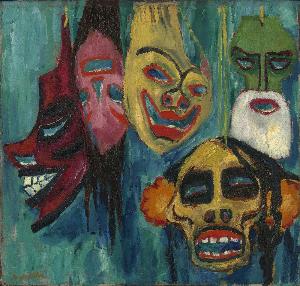Hans Emil Hansen
Hans Emil Hansen;Emil Nolde
Place: Nolde
Born: 1867
Death: 1956
Biography:
Early Life and Career
Hans Emil Hansen, later known as Emil Nolde, was born on August 7, 1867, in the Prussian Duchy of Schleswig. This German-Danish painter and printmaker would become one of the first Expressionists and a member of Die Brücke (The Bridge), a revolutionary art movement. Between 1884 and 1891, Hansen studied to become a woodcarver and illustrator in Flensburg. He worked in furniture factories as a young adult and later gained entrance into the School of Applied Arts in Karlsruhe in 1889. After being rejected by the Munich Academy of Fine Arts in 1898, he took private painting classes and visited Paris, becoming familiar with the contemporary impressionist scene.
Artistic Career and Associations
In 1906, Hansen became a member of Die Brücke (The Bridge), a group that would define his artistic style. However, this association lasted only until the end of the following year. He was also a member of the Berlin Secession from 1908 to 1910 but was excluded due to a disagreement with the leadership.
- Man, Woman and Cat (1912), a work influenced by his studies at the Völkerkundemuseum in Königgrätzer Straße, Berlin.
- Exhibition with Wassily Kandinsky's Munich-based group Der Blaue Reiter (The Blue Rider) in 1912, marking a significant point in his career.
Politics and Later Life
Support for the National Socialist German Workers' Partyfrom the early 1920s led to Nolde's views on Expressionism being seen as distinctly Germanic. However, Adolf Hitler rejected all forms of modernism as "degenerate art", and the Nazi regime officially condemned Nolde's work.
- A total of 1,052 of his works were removed from museums.
- Nolde's later life was marked by controversy, with his support for the Nazi party contrasting sharply with his earlier artistic achievements.
Legacy and Remembrance
Despite the tumultuous end to his career, Nolde's impact on Expressionism remains significant. His work can be found in various museums, including The Brücke-Museum Berlin, which is dedicated to the art movement he was once a part of.
- Explore more about Die Brücke (The Bridge) and its influence on Nolde's work at [https://Wikioo.org/@@/A@D3CK5H-The-Brucke-Museum-Berlin-Germany](https://Wikioo.org/@@/A@D3CK5H-The-Brucke-Museum-Berlin-Germany)
- Learn more about Nolde's life and controversies at [https://en.wikipedia.org/wiki/Emil_Nolde](https://en.wikipedia.org/wiki/Emil_Nolde)
Key Works and Collections
Hans Emil Hansen (Nolde)'s work can be found in various collections, including those at the Museum Collection Hugo Fischer (Bühl, Germany), which showcases the evolution of German and European painting.
- Flower Garden (Girl and Washing), a quintessential representation of Nolde's unique style.
- The Street by Ernst Ludwig Kirchner, an example of the group's use of bold colors and expressive brushstrokes.
* [https://Wikioo.org/@/Hans-Emil-Hansen](https://Wikioo.org/@/Hans-Emil-Hansen) - Explore Nolde's artworks on Wikioo.org. * [https://en.wikipedia.org/wiki/Emil_Nolde](https://en.wikipedia.org/wiki/Emil_Nolde) - Read more about Nolde's life and controversies on Wikipedia.





